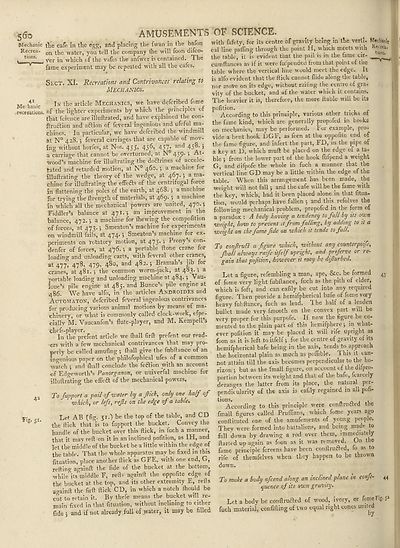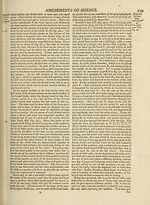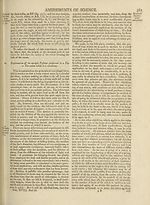Encyclopaedia Britannica, or, a Dictionary of arts, sciences, and miscellaneous literature : enlarged and improved. Illustrated with nearly six hundred engravings > Volume 18, RHI-SCR
(582) Page 560
Download files
Complete book:
Individual page:
Thumbnail gallery: Grid view | List view

5 Go
AMUSEMENTS
Mechanic the cafe in the egg, and placing the fwan in the baton
Recrea- on tj1R water, you tell the company Ihe will foon difco-
t,or"i‘ , Ver in which of the vafes the anfwer is contained. The
fame experiment may be repeated with all the cafes.
Sect. XI. Recreations and Contrivances ' relating to
Mechanics.
Me hanic artic^c MECHANICS, we haVe defefibed fome
■recreations, of the lighter experiments by which the principles of
that fcience are illuftrated, and have explained the con*
ftru&ion and aftion of feveral ingenious and ufeful ma¬
chines. In particular, we have deferibed the windmill
at N° 428. *, feveral carriages that are capable of mov¬
ing without horfes, at Nos. 455’ 45^’ 457^ an<^ 45^* i
a carriage that cannot be overturned, at N° 459. •, At¬
wood’s machine for illuftrating the doftrines of accele¬
rated and retarded motion, at N° 460. •, a machine tor
illuftrating the theory of the wedge, at 467.5 a ma¬
chine for illuftrating the effefts of the centrifugal force
in flattening the poles of the earth, at 468. j a machine
for trying the ftrength of materials, at 4^9* ’ a machine
in which all the mechanical powers are united,.470. *,
Fiddler’s balance at 471.; an improvement in the
balance, 472. ; a machine for fhewing the compofition
of forces, at 473*} Smeaton’s machine for experiments
on windmill fails, at 474.; Smeaton’s machine for ex¬
periments on rotatory motion, at 475. ; Prony’s con-
denfer of forces, at 476. *, a portable ftone crane for
loading and unloading carts, with feveral other cranes,
at 477, 478, 479, 480, and 482. j Bramah’s jib for
cranes, at 481. ; the common worm-jack, at 483. •, a
portable loading and unloading machine at.484.} Vau-
loue’s pile engine at 485. and Bunce’s pile engine at
486. We have alfo, in the articles AndROID.ES and
Automaton, deferibed feVeral ingenious contrivances
for producing various animal motions by means of ma¬
chinery, or what is commonly called clock-work, efpe-
ciallv M. Vaucanfon’s flute-player, and M. Kempell’s
cheft-playcr.
In the prefent article we {hall firft prefent our read¬
ers with a few mechanical contrivances that may pro¬
perly be called amufing ; (hall give the fubftance of an
ingenious paper on the philofophical ufes of a common
watch ; and ftrall conclude the feftion with an account
of Edgeworth’s Panorganon, or uuiverfal machine for
illuftrating the effea of the mechanical powers.
, 2 To fupport a pail of water by a Jhch, only one half of
which, or lefs, refs on the edge of a table.
Let AB (fig. 51O be the top of the table, and CD
the ftick that is to fupport the bucket. Convey the
handle of the bucket over this ftick, in.iuch a manner,
that it may reft on it in an inclined pofition, as IH, and
let the middle of the bucket be a little within the edge of
the table. That the whole apparatus may be fixed in this
fituation, place another ftick as GFE, with one end, G,
refting againft the fide of the bucket at the bottom,
while its middle E, refts againft the oppofite edge of
the bucket at the top, and its other extremity E, refts
aaainft the firft ftick CD, in which a notch fhould be
cut to retain it. Bv thefe means the bucket will re¬
main fixed in that fituation, without inclining to either
fide ; and if not already full of water, it may be filled
OF SCIENCE.
with fafety, for its centre of gravity being in the verti- Meehan;,
cal line palling through the point H, which meets with
the table, it is evident that the pail is in the fame cir-
cumftances as if it were fufpended from that point ot the
table where the vertical line would meet the edge. It
is alfo evident that the ftick cannot Hide along the table,
nor moVe on its edge, without railing the centre of gra¬
vity of the bucket, and of the water winch it contains.
The heavier it is, therefore, the more ftable will be its
pofition. • • r
According to this principle, various other tricks of
the fame kind, which are generally propofed in books
on mechanics, may be performed. lor example, pro¬
vide a bent hook DGF, as feen at the oppofite end of
the fame figure, and infert the part, FD, in the pipe of
a key at D, which muft be placed on the edge of a ta¬
ble ; from the lower part of the hook fufpend a weight
G, and difpofe the whole in fuch a. manner that the
vertical line GD may be a little within the edge of the
table. When this arrangement has been made, the
weight will not fall j and the cafe will be the fame with
the key, which, had it been placed alone in that fitua¬
tion, would perhaps have fallen } and this refolves the
following mechanical problem, propofed in the form of
a paradox : A body having a tendency to fall by its own
weight, how to prevent it from falling, by adding to it a
weight on the fame fide on which it tends to fail.
To confruEl a figure which, without any counterpoife,
fijall always raife itfelf upright, and preferve or re¬
gain that pofition, however it ntay be difiurbed.
Let a figure, refembling a man, ape, &c. be formed 43
of fome very light fubftance, fuch as the pith of elder,
which is foft, and can eafily be cut into any required
figure. Then provide a hemifpherical bafe of fome very
heavy fubftance, fuch as lead. I he half of a leaden
bullet made very fmooth on the convex part will be
very proper for this purpofe. If now the figure be ce¬
mented to the plain part of this hemifphere j in what¬
ever pofition it may be placed it will rife upright as
foon as it is left to itfelf; for the centre of gravity of its
hemifpherical bafe being in the axis, tends to.approach
the horizontal plain as much as pcflible. 1 his it can¬
not attain till the axis becomes perpendicular to the ho¬
rizon •, but as the fmall figure, on account of the difpro-
portion between its weight and that of the bafe, fcaicely
deranges the latter from its place, the natural per-
pendit ularity of the axis is eafily regained in all pofi-
tions, _ ^ « n 1 r
According to this principle were conftruefed the
fmall figures called Pruffians, which fome years ago
conftituted one of the amufements of young people.
They were formed into battalions, and being made to
fall down by drawing a rod over them, immediately
ftarted up again as foon as it tvas removed. On the
fame principle fereens have been conftruaed, fo as to
rife of themfelves when they happen to be thrown
down.
To make a body afeend along an inclined plane in confie- 44
qucncc of its own gravity.
Let a body be conftru&ed of wood, ivory, or fome Fig. 51
fuch material, confifting of two equal right cones united
AMUSEMENTS
Mechanic the cafe in the egg, and placing the fwan in the baton
Recrea- on tj1R water, you tell the company Ihe will foon difco-
t,or"i‘ , Ver in which of the vafes the anfwer is contained. The
fame experiment may be repeated with all the cafes.
Sect. XI. Recreations and Contrivances ' relating to
Mechanics.
Me hanic artic^c MECHANICS, we haVe defefibed fome
■recreations, of the lighter experiments by which the principles of
that fcience are illuftrated, and have explained the con*
ftru&ion and aftion of feveral ingenious and ufeful ma¬
chines. In particular, we have deferibed the windmill
at N° 428. *, feveral carriages that are capable of mov¬
ing without horfes, at Nos. 455’ 45^’ 457^ an<^ 45^* i
a carriage that cannot be overturned, at N° 459. •, At¬
wood’s machine for illuftrating the doftrines of accele¬
rated and retarded motion, at N° 460. •, a machine tor
illuftrating the theory of the wedge, at 467.5 a ma¬
chine for illuftrating the effefts of the centrifugal force
in flattening the poles of the earth, at 468. j a machine
for trying the ftrength of materials, at 4^9* ’ a machine
in which all the mechanical powers are united,.470. *,
Fiddler’s balance at 471.; an improvement in the
balance, 472. ; a machine for fhewing the compofition
of forces, at 473*} Smeaton’s machine for experiments
on windmill fails, at 474.; Smeaton’s machine for ex¬
periments on rotatory motion, at 475. ; Prony’s con-
denfer of forces, at 476. *, a portable ftone crane for
loading and unloading carts, with feveral other cranes,
at 477, 478, 479, 480, and 482. j Bramah’s jib for
cranes, at 481. ; the common worm-jack, at 483. •, a
portable loading and unloading machine at.484.} Vau-
loue’s pile engine at 485. and Bunce’s pile engine at
486. We have alfo, in the articles AndROID.ES and
Automaton, deferibed feVeral ingenious contrivances
for producing various animal motions by means of ma¬
chinery, or what is commonly called clock-work, efpe-
ciallv M. Vaucanfon’s flute-player, and M. Kempell’s
cheft-playcr.
In the prefent article we {hall firft prefent our read¬
ers with a few mechanical contrivances that may pro¬
perly be called amufing ; (hall give the fubftance of an
ingenious paper on the philofophical ufes of a common
watch ; and ftrall conclude the feftion with an account
of Edgeworth’s Panorganon, or uuiverfal machine for
illuftrating the effea of the mechanical powers.
, 2 To fupport a pail of water by a Jhch, only one half of
which, or lefs, refs on the edge of a table.
Let AB (fig. 51O be the top of the table, and CD
the ftick that is to fupport the bucket. Convey the
handle of the bucket over this ftick, in.iuch a manner,
that it may reft on it in an inclined pofition, as IH, and
let the middle of the bucket be a little within the edge of
the table. That the whole apparatus may be fixed in this
fituation, place another ftick as GFE, with one end, G,
refting againft the fide of the bucket at the bottom,
while its middle E, refts againft the oppofite edge of
the bucket at the top, and its other extremity E, refts
aaainft the firft ftick CD, in which a notch fhould be
cut to retain it. Bv thefe means the bucket will re¬
main fixed in that fituation, without inclining to either
fide ; and if not already full of water, it may be filled
OF SCIENCE.
with fafety, for its centre of gravity being in the verti- Meehan;,
cal line palling through the point H, which meets with
the table, it is evident that the pail is in the fame cir-
cumftances as if it were fufpended from that point ot the
table where the vertical line would meet the edge. It
is alfo evident that the ftick cannot Hide along the table,
nor moVe on its edge, without railing the centre of gra¬
vity of the bucket, and of the water winch it contains.
The heavier it is, therefore, the more ftable will be its
pofition. • • r
According to this principle, various other tricks of
the fame kind, which are generally propofed in books
on mechanics, may be performed. lor example, pro¬
vide a bent hook DGF, as feen at the oppofite end of
the fame figure, and infert the part, FD, in the pipe of
a key at D, which muft be placed on the edge of a ta¬
ble ; from the lower part of the hook fufpend a weight
G, and difpofe the whole in fuch a. manner that the
vertical line GD may be a little within the edge of the
table. When this arrangement has been made, the
weight will not fall j and the cafe will be the fame with
the key, which, had it been placed alone in that fitua¬
tion, would perhaps have fallen } and this refolves the
following mechanical problem, propofed in the form of
a paradox : A body having a tendency to fall by its own
weight, how to prevent it from falling, by adding to it a
weight on the fame fide on which it tends to fail.
To confruEl a figure which, without any counterpoife,
fijall always raife itfelf upright, and preferve or re¬
gain that pofition, however it ntay be difiurbed.
Let a figure, refembling a man, ape, &c. be formed 43
of fome very light fubftance, fuch as the pith of elder,
which is foft, and can eafily be cut into any required
figure. Then provide a hemifpherical bafe of fome very
heavy fubftance, fuch as lead. I he half of a leaden
bullet made very fmooth on the convex part will be
very proper for this purpofe. If now the figure be ce¬
mented to the plain part of this hemifphere j in what¬
ever pofition it may be placed it will rife upright as
foon as it is left to itfelf; for the centre of gravity of its
hemifpherical bafe being in the axis, tends to.approach
the horizontal plain as much as pcflible. 1 his it can¬
not attain till the axis becomes perpendicular to the ho¬
rizon •, but as the fmall figure, on account of the difpro-
portion between its weight and that of the bafe, fcaicely
deranges the latter from its place, the natural per-
pendit ularity of the axis is eafily regained in all pofi-
tions, _ ^ « n 1 r
According to this principle were conftruefed the
fmall figures called Pruffians, which fome years ago
conftituted one of the amufements of young people.
They were formed into battalions, and being made to
fall down by drawing a rod over them, immediately
ftarted up again as foon as it tvas removed. On the
fame principle fereens have been conftruaed, fo as to
rife of themfelves when they happen to be thrown
down.
To make a body afeend along an inclined plane in confie- 44
qucncc of its own gravity.
Let a body be conftru&ed of wood, ivory, or fome Fig. 51
fuch material, confifting of two equal right cones united
Set display mode to:
![]() Universal Viewer |
Universal Viewer | ![]() Mirador |
Large image | Transcription
Mirador |
Large image | Transcription
Images and transcriptions on this page, including medium image downloads, may be used under the Creative Commons Attribution 4.0 International Licence unless otherwise stated. ![]()
| Permanent URL | https://digital.nls.uk/193026273 |
|---|
| Attribution and copyright: |
|
|---|
| Description | Ten editions of 'Encyclopaedia Britannica', issued from 1768-1903, in 231 volumes. Originally issued in 100 weekly parts (3 volumes) between 1768 and 1771 by publishers: Colin Macfarquhar and Andrew Bell (Edinburgh); editor: William Smellie: engraver: Andrew Bell. Expanded editions in the 19th century featured more volumes and contributions from leading experts in their fields. Managed and published in Edinburgh up to the 9th edition (25 volumes, from 1875-1889); the 10th edition (1902-1903) re-issued the 9th edition, with 11 supplementary volumes. |
|---|---|
| Additional NLS resources: |
|

